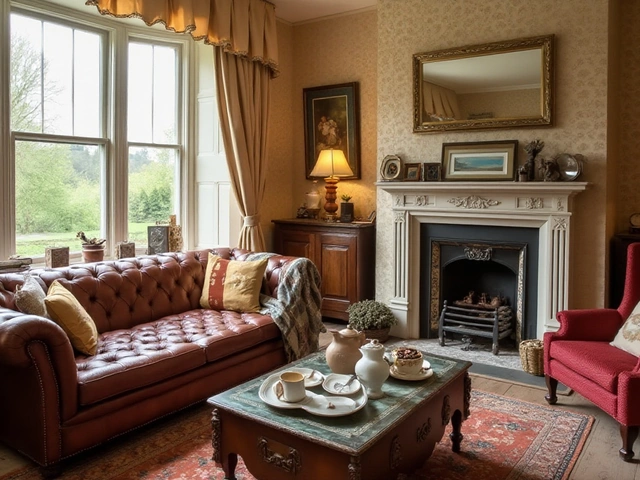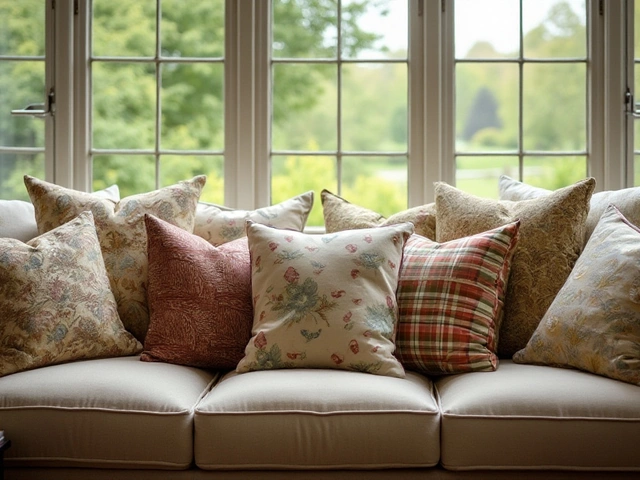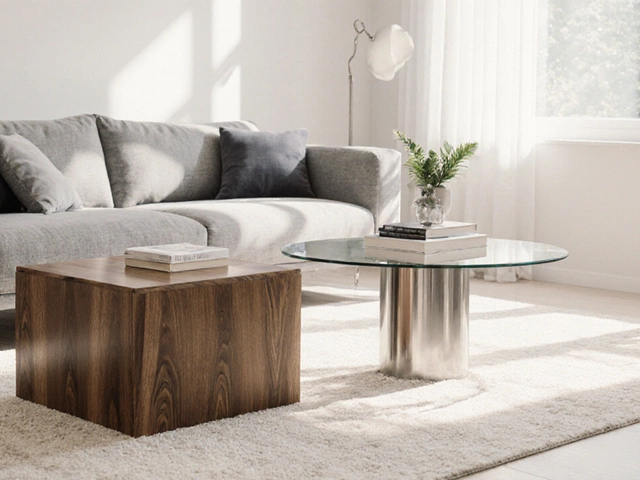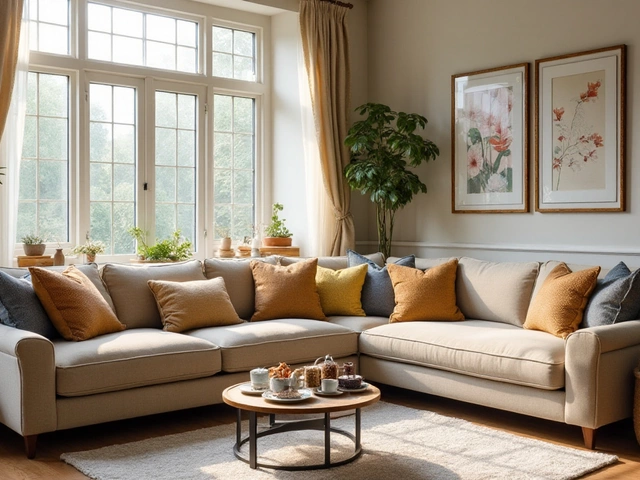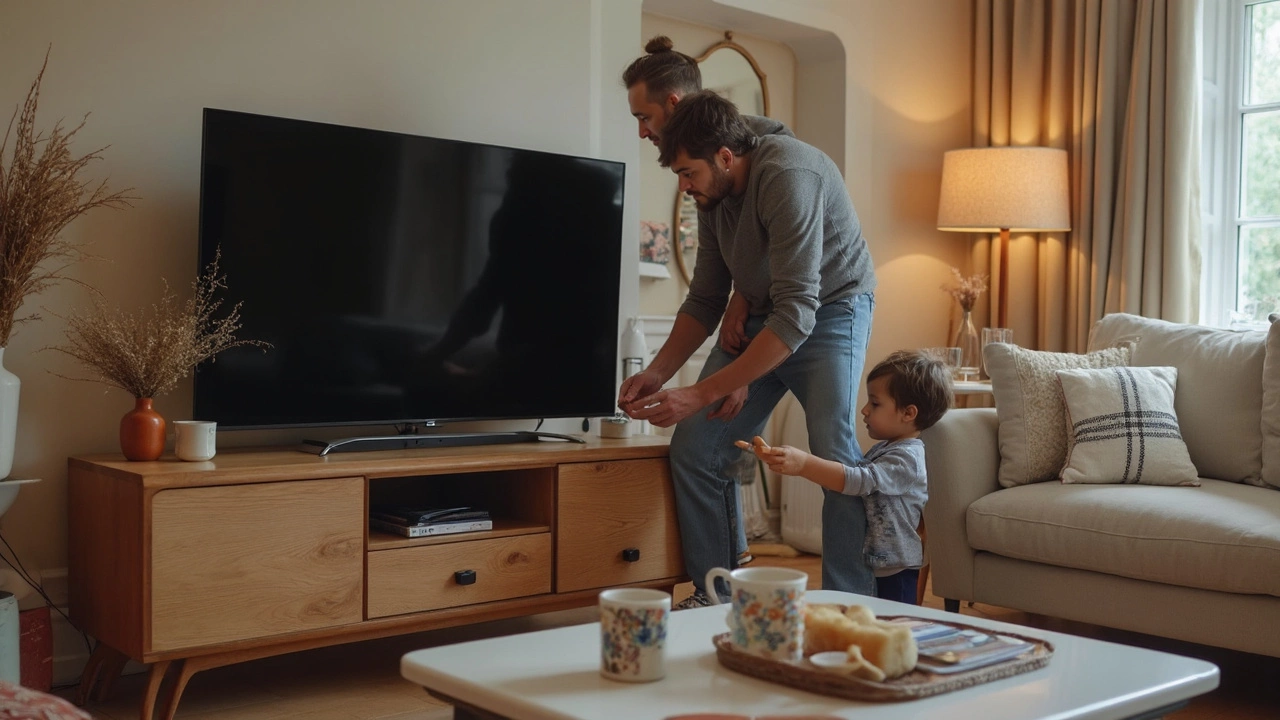 26
Apr,2025
26
Apr,2025
Walk into almost any living room, and you’ll see one clear focus: the TV. But here’s the twist—not everyone handles where their TV goes the same way. Some mount it on the wall like a piece of art, while others still park it proudly on a TV stand. Does anyone even use TV stands anymore?
The answer isn’t as obvious as you might think. Even with all-in-one wall mounts grabbing attention, TV stands keep showing up in furniture stores and online. There’s a good reason for that. TV stands aren’t just for holding the TV; they do double-duty as storage for your gaming consoles, streaming devices, or that tangle of remote controls. For renters or anyone who hates drilling holes, stands are just way simpler too.
If you’re rearranging your living room or finally upgrading that ancient TV, figuring out what to set it on can change the whole vibe of your space. You don’t just want something sturdy—you want something that works for your stuff, looks good, and actually fits your lifestyle.
- Why TV Stands Still Matter Today
- Wall Mounts vs. TV Stands: What Fits Your Space
- Style and Storage: Why Some Prefer a Stand
- Modern TV Stands: What’s Out There
- Tips for Picking the Right TV Stand
Why TV Stands Still Matter Today
Here’s the thing: despite all the hype around wall-mounted TVs, TV stands are still hanging on for real reasons. First up, not everyone wants to drill holes into their rented apartment walls or deal with hunting for wall studs. Stands are the low-stress alternative—you unpack them, slide in your TV, and you’re good to go.
There’s also a practical side. TV stands offer extra home entertainment storage you just can’t get from a wall mount. You get spots for your gaming consoles, router, soundbar, Blu-ray player, or even just a basket for remotes and cords. This makes life less cluttered, especially if you’re into streaming or gaming.
Another real-world fact: TVs keep getting bigger, and not every wall can safely support a 75-inch monster. Some TV stands can hold screens up to 100 inches if you pick a solid one. Plus, if something comes up—like moving to a new place or needing to shuffle furniture—TV stands are way less hassle. Just unplug, lift (you might need a buddy for bigger ones), and you’re ready to roll.
Here’s a quick look at why people stick with TV stands:
- Simple setup. No tools needed for drilling into walls.
- Flexible placement. Move your living room furniture anytime you want a new look.
- Storage galore. Keeps all your devices and games in one spot.
- Safe choice for renters or anyone who’s not sure about wall mounting.
Stores keep stocking TV stands because people still want them. In fact, a 2024 survey from a leading home goods retailer showed about 44% of shoppers prefer a stand over a wall mount, especially in apartments or family rooms where things move around more.
Wall Mounts vs. TV Stands: What Fits Your Space
Picking between a TV stand and a wall mount isn’t just about looks—it totally depends on your living situation, your TV, and your stuff. If you rent or move a lot, TV stands let you skip drilling into the wall. Even if you own your place, mounting a big TV is tough when you have plaster or brick walls. Not everyone wants to mess with anchors or a stud finder.
Wall mounts free up floor space and give you that fancy, clean look you see in modern homes. It’s a win for folks with smaller spaces or who just want less clutter. On the flip side, if you’re always adding gadgets—game consoles, soundbars, or streaming boxes—a stand is way easier. It turns into storage and a hiding spot for those endless cords.
| Feature | Wall Mount | TV Stand |
|---|---|---|
| Space Saving | Yes | No |
| Storage | No | Yes |
| Moving/Adjusting | Harder | Easy |
| Renter-Friendly | No | Yes |
| Hides Cables | Requires extra work | Usually built-in |
Some people just like their TV higher or tilted, and many mounts let you adjust angles. But here’s something a lot of people forget—if your walls aren’t sturdy, mounting is risky. Cheap drywall and heavy TVs never mix well.
For anybody with kids or curious pets, TV stands with straps or anti-tip kits can keep things safe, while wall mounts get those screens completely out of reach. Your call really comes down to which fits your room, your routine, and how much tech you’re juggling around the TV.

Style and Storage: Why Some Prefer a Stand
If you ask people why they still use TV stands, style and storage almost always come up. It’s not just about plopping a screen anywhere—many want their living rooms to look put-together and practical. TV stands hit both goals at once.
First off, there’s the style factor. TV stands come in just about every look you can imagine—minimalist metal, classic wood, glossy modern finishes, you name it. Want your living room to match a farmhouse vibe, or do you gravitate to a sleek, ultra-modern look? You’ll find a stand that actually fits the room’s theme instead of sticking out like a sore thumb.
Next is storage. Wall mounts can be neat, but where does all your other stuff go? The average home has at least three extra gadgets hooked up to a TV: soundbars, game consoles, routers, or streaming boxes usually land somewhere in the setup. TV stands offer shelves, cabinets, and sometimes drawers to hide away clutter. No one wants to trip over cords or see their living room turn into a tech junkyard.
To show just how practical these stands are, check out what most folks use them for:
- Keeping game consoles and streaming devices out of sight but easy to reach
- Storing extra remotes (nobody wants to dig under the couch, right?)
- Holding collections like DVDs or games in one spot
- Managing cables with built-in holes or channels to keep things tidy
What’s interesting is a 2023 survey from Statista found that about 58% of people under 40 still buy a dedicated TV stand when upgrading entertainment gear—so it’s not just your parents holding onto them.
Choosing a stand isn’t just about style or storage—it’s about keeping your living space organized and making it feel like home, all while keeping your tech in check. If you love switching up your space, a TV stand is way easier to move than a mount, too.
Modern TV Stands: What’s Out There
Today’s TV stands have come a long way from the clunky cabinets you might remember from the early 2000s. The current market is all about clean lines, compact designs, and utility that matches up with smart homes and streaming setups. You’ll spot everything from ultra-slim metal frames to chunky wood units with tons of drawers and shelves.
If you poke around furniture shops or scroll through the big online stores, you’ll notice a few types standing out:
- Open-shelf stands: Perfect for people who want their consoles and sound systems on display. These usually ditch doors and drawers for quick access and a lighter look.
- Enclosed cabinets: Great for hiding wires, routers, or anything else you don’t want guests to see. These help keep your living room looking uncluttered, especially if you have lots of media gear.
- Floating stands: These mount to the wall a few inches off the floor (not to be confused with wall-mounting your TV). They’re trendy for that “minimalist” vibe and make it easy to clean underneath.
- Corner units: If you’re tight on space, these angled TV stands fit snugly in a corner and still support big screens.
Material matters, too. Right now, wood (especially lighter finishes), tempered glass, and metal are big. Many stands come with pre-made holes or panels for cable management, which is a small feature that makes a huge difference when you’re plugging in game consoles or setting up a chunky soundbar.
Here’s a quick look at some recent trends in TV stand shopping:
| Style | Most Common Features |
|---|---|
| Mid-century modern | Splayed wooden legs, natural veneers, open shelving |
| Industrial | Metal frames, reclaimed wood, exposed hardware |
| Minimalist | Sleek surfaces, handleless doors, floating designs |
| Multi-functional | Fireplace inserts, built-in charging stations, heavy storage |
Another thing to keep in mind: the average size of home TVs has jumped over the years. In 2015, 40-inch screens were normal. Now, the sweet spot is closer to 55 or even 65 inches for a lot of folks. Modern TV stands are built for these bigger screens, with wider tops and beefier supports, so you don’t have to worry about your pricey smart TV tipping over if you have a pet or a kid running around.
If you’re after smart features, some stands even come with LED backlighting, cable trays, or spots to hide that ugly power strip. So whether your style leans modern, classic, or you just need something to keep your gear organized, there’s a ton of options that go way beyond just being a simple table for your TV.

Tips for Picking the Right TV Stand
If you’re serious about finding the right TV stand, it pays to think about more than just looks. You want something that nails both style and function—without turning your living room into a clutter trap.
- Measure, measure, measure. Start by checking the width of your TV. Your stand should be at least a couple of inches wider on each side, especially for bigger screens. If you use a soundbar, make sure the stand is long enough to fit both.
- Check the weight limit. Some new TVs are super light, but not all. Every stand has a max weight limit—find it before you buy, then make sure your TV falls under it (don’t just guess).
- Think about storage. If you have a gaming console, streaming box, or old-school DVD collection, look for a stand with shelves, drawers, or hidden compartments. Solid doors keep things dust-free, while open shelves are better for devices with remotes.
- Pick a height that works. The ideal setup has your TV screen’s middle just about eye level when you’re sitting down. Standard couch height is 18–20 inches off the ground, so stands around 20–26 inches high usually work best for most people.
- Style and material matter. MDF and particleboard stands are usually more affordable, but not as tough as solid wood or metal options. Glass tops look sleek but show fingerprints and dust faster. Make sure the style fits the rest of your furniture, unless you really want that college-dorm vibe.
If you’re curious what's trending, check this quick comparison of common TV stand materials and how people feel about them (according to a Statista report from 2024):
| Material | Popularity (%) | Durability |
|---|---|---|
| Solid Wood | 38 | High |
| MDF/Particleboard | 35 | Medium |
| Metal | 15 | High |
| Glass | 12 | Low |
Don’t forget cable management. A lot of new stands have holes or channels in the back so your wires don’t look like a rat’s nest. And, if you plan to move soon or swap apartments often, consider something lighter and easy to assemble.
At the end of the day, the right TV stand is the one that holds up your screen, blends with your space, and keeps your stuff in check. Buy what makes sense for your real life, not just what looks hot on Pinterest or in a showroom.
